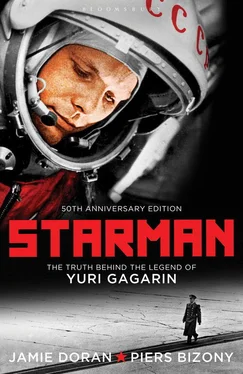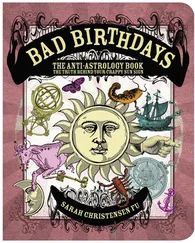Afterwards, while they were leaving the construction hall, the cosmonauts chattered eagerly about Vostok and who would be first to fly it. Alexei Leonov remembers putting his arm around Gagarin and saying, ‘Believe me, today could’ve been very important for you. I know you can be the first to go.’ Several in the group chimed in their agreement. Gagarin had made an impression back there.
Meanwhile Valya was beginning to understand the pitfalls of being a cosmonaut’s wife. As she told journalist Yaroslav Golovanov in 1978, ‘Yuri would often come home late, and he frequently went on trips to do with his work. He wasn’t very communicative about what he did, and if I ever showed any curiosity he would dismiss it with a joke. I know he wasn’t allowed to talk about these things even with his family, but it sometimes seemed to me that his work at Star City was taking him away from me more and more. I tried to make it seem that I hadn’t noticed, but from time to time I would be overcome by a strange anxiety.’ [8] Quoted in Golovanov, Our Gagarin , p. 265.
One day towards the end of 1960 Gagarin brought some of his cosmonaut friends home, and Valya, coming in from work at the Star City clinic, overheard them whispering. ‘It’ll be soon now. Either Yuri or Gherman.’
When Korolev and his colleagues brought home captured German V-2s and began to fire them, they built a small testing station 180 kilometres east of Volgograd (then called Stalingrad) near a small town called Kapustin Yar. In January 1957 work began on a much larger and more permanent base at Plesetsk, on the Arctic Circle, because trans-polar trajectories offered the shortest ballistic routes into the North American continent. Plesetsk became the principal base for Soviet intercontinental nuclear missiles – though the ‘missile gap’ which John F. Kennedy spoke of so effectively in his 1960 election campaign was largely a myth. Kennedy presented a frightening vision of vast numbers of Soviet missiles aimed at the US, and urged the building of an adequate counterstrike force to reduce the supposed ‘gap’ between Russian and US capability. In fact, at that time Plesetsk could handle no more than four of Korolev’s R-7 rockets at a time, and it is unlikely that they could have been launched all at once. The missile gap was, if anything, greatly in America’s favour.
The Soviets’ most famous launch station was built as close to the Equator as they could manage, so that the west–east rotation of the earth would impart extra energy to departing heavy rockets. On May 31, 1955, supervising engineer Vladimir Barmin and his men turned over the first clump of soil in one of the loneliest places on earth: a vast, utterly flat, barren steppe in the middle of the southern republic of Kazakhstan. The new complex was built around an old settlement called Tyura’tam, named by the nomad Kazakhs for the burial site of Genghis Khan’s beloved son Tyura, although another translation was ‘Arrow Burial Place’, which was not considered appropriate for a rocket-launching station. The Soviets swept aside the old name and called the place ‘Baikonur’, which was actually a small town 370 kilometres to the north-east. This was a bid to confuse the Western Intelligence agencies about the base’s location, although they discovered the truth as soon as the first R-7 ICBM prototype was successfully launched from Baikonur (after two failures) on August 3, 1957 and was monitored by radar stations in Turkey. Near the rocket base the Soviets founded a new city called Leninsk to house 100,000 Russian technicians, along with 30,000 soldiers to guard them.
Several metres of snow cover the steppe from October through to March, and blizzards are frequent. Only in April does the place become bearable, when the snow melts and the steppe comes into bloom for two or three weeks. As the flowers fade and the last of the meltwaters evaporate to leave shallow pools, the mosquitoes breed. Then, in the long summer, the earth hardens like brick, the heat is remorseless and sandstorms are a constant hazard for people and machines alike.
At first glance the engineers working on the Baikonur complex in 1955 could have been mistaken for political prisoners. They lived in tents, by turns freezing and sweltering, and their equipment was so inadequate that they had to start their work using just shovels and spades. Their first task was to run a triangular spur from the Moscow–Tashkent railway (which itself followed an ancient nomadic caravan route). While NASA supplied its launch centre in Florida with an endless succession of cargo planes, barges, helicopters and 16-wheel trucks cruising along smooth highways, the Soviets went into space by train. Only when the rail spur deep into the steppe was completed could proper construction machinery arrive at Baikonur. [1] For a description of Baikonur’s construction, see Harvey, Brian, The New Russian Space Programme , New York: John Wiley & Sons, 1996, pp. 19–20, Kapustin Yar, pp. 141–3, Plesetsk, pp. 143–40.
Within two years the construction workers completed an airport, a huge hangar bay where rockets could be assembled and checked under shelter, control blockhouses, and a support platform and flame trench for the base of the first launch tower. The 250-metre-long platform, supported on solid concrete pillars the height and size of apartment buildings, jutted out over the reinforced slope of an old mine working, like a giant balcony over a hillside. Rockets would be suspended by clamps with their engines pointing down through a large square hole in the platform, so that in the first moments of ignition the engines’ blazing exhaust products would shoot through the hole and down onto the slope, to be deflected harmlessly away from the pad.
Other launch pads soon followed, and over the next decade Baikonur’s various facilities sprawled across hundreds of square kilometres of the steppe. Until 1973 no American had ever seen this place, except as a vague pattern of rectangles, lines and shadows in high-altitude reconnaissance photos, taken at great risk by spy planes flying out of Turkey. In fact one of the worst embarrassments in the history of US reconnaissance occurred on May 1, 1960, when a U-2 aircraft was shot down over the Ural mountains. Its mission was to overfly Baikonur and photograph the launch pads. The pilot, Gary Powers, was captured and put on trial in Moscow, much to Khrushchev’s glee. The US president, Dwight D. Eisenhower, in his last months of office, made empty protests about an unprovoked attack on ‘an American weather research aircraft flying from a base in Turkey’, which had ‘inadvertently strayed off-course’. [2] Daily Telegraph , May 6, 1960, p. 1.
Immediately Eisenhower banned any further U-2 overflights of Soviet territory.
In the wake of this humiliation, one of the most costly, secret and technologically sophisticated space efforts was born: the US spy-satellite programme, run largely by the CIA and the Department of Defense. Their projects came to be known as ‘black’, because nobody ever knew very much about them, despite budgets that matched, or even exceeded, the funds allocated to NASA’s more visible space exploration projects. [3] Secret US space projects are outlined in Trento, Joseph, Prescription for Disaster , London: Harrap, 1987, pp. 122–49.
No longer a secret, the first R-7 launch pads at Baikonur are still in operation today. Stars painted onto the metal gantries denote the number of launches – one star for every fifty launches. One gantry is decorated with six stars… This is the facility from which the world’s first manned space mission was launched. Today it despatches Soyuz crew-ferries to the orbiting Russian space station Mir.
Читать дальше












